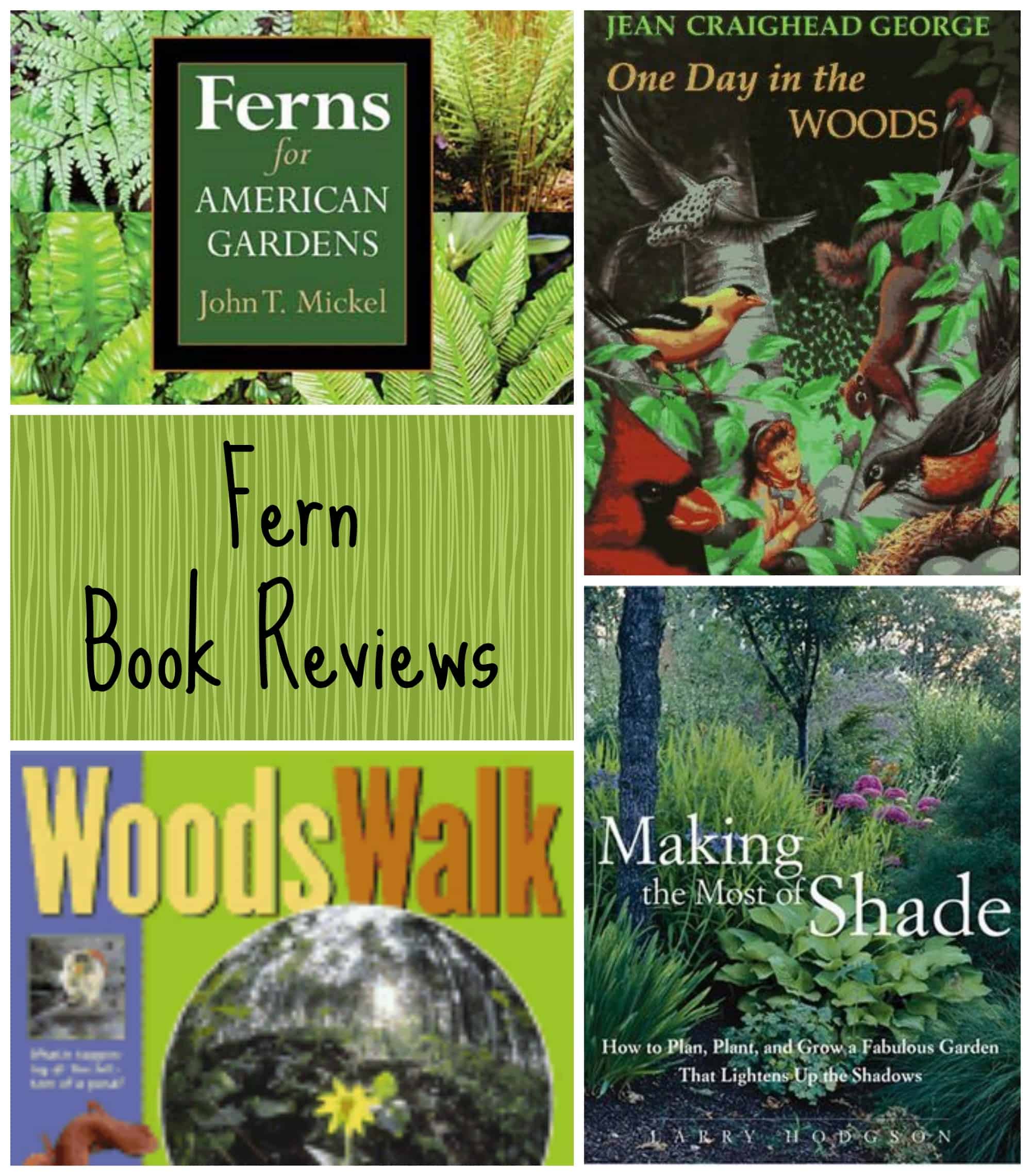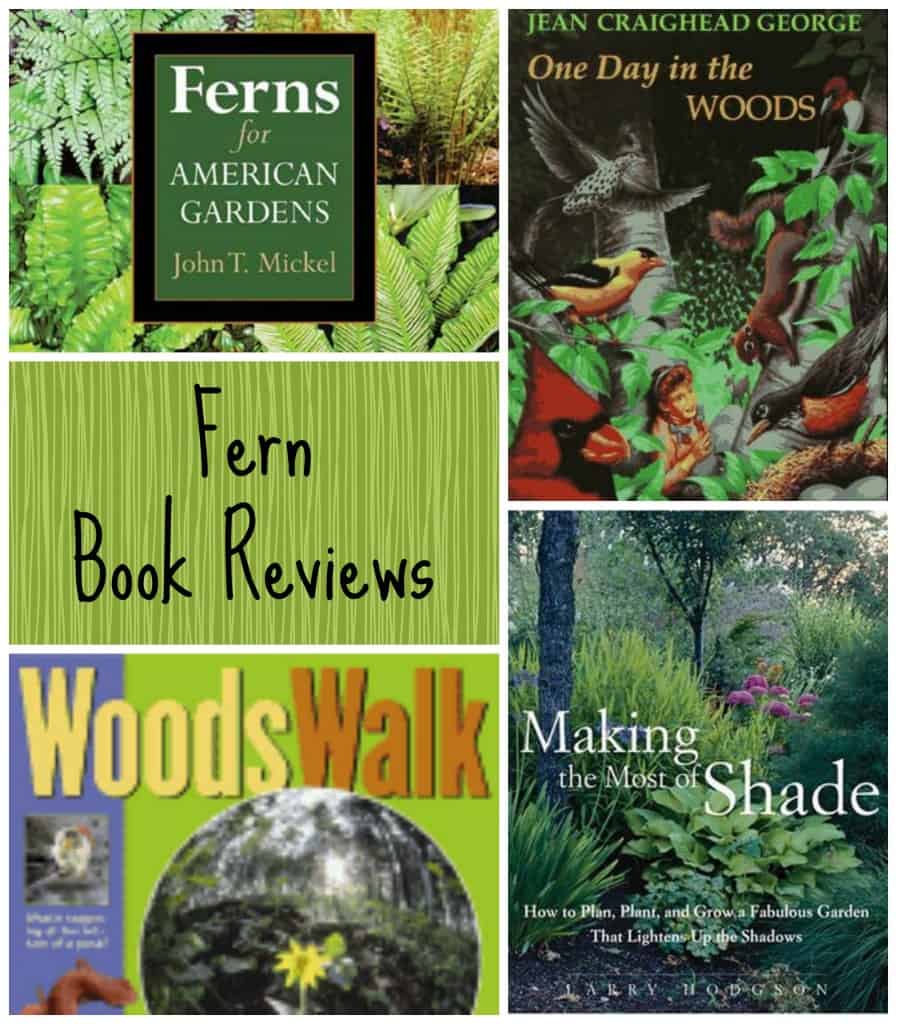Hi there! We use affiliate links where relevant for products that we love. This means that companies say, “hey thanks for telling people about us!” by giving us a small commission as a result (Trust us, guys, it’s SMALL!) That being said, our opinions are always our own. Thanks for reading!
A unit on ferns. . . those never blooming plants with delicate leaves or fronds, generally green, often found in the woodlands. . .what a great idea! Follow us for the next week and try the solar project with ferns or a woodland walk. Hopefully you’ll be inspired to take a walk in the woods near you. The book reviews for this unit on ferns contains two books for children and two for adults. Grab the kids and head to the library.
It was difficult to find a children’s books on ferns. With a little research I found several books about the woodlands that did have information or a story line which contained information on ferns.
One Day in the Woods by Jean Craighead George and illustrated by Gary Allen
Rebecca is a young girl and explorer. The book begins with her early morning climb to the top of a tree to inspect a robin’s nest. A search for the ovenbird, a warbler described by her uncle Luke as “the wizard of the woods”, prompts her to leave the tree and begin her exploration of the woods. Rebecca explores the forest equipped with a daypack which contains a magnifying glass and some water. Each of the forest layers and the plants and animals that are found within each layer are beautifully described and illustrated with pencil drawings. As Rebecca explores the forest she drops her magnifying glass from her daypack. Kneeling down to get a closer look at the earthworms and slugs in the litter layer, Rebecca remembers that her magnifying glass was dropped at the beech tree.
What happens when the sun shines through a magnifying glass? As Rebecca approaches the tree she sees a ribbon of smoke. Before she can get her jacket off, the fire on the leaves quickly dies down.
Near the end of her day of exploration, Rebecca finds the ovenbird, the “wizard of the woods”.
There are many reasons to love this book. The weaving of a good story with scientific information makes this book a standout. Each of the five layers of the forest, and the plants and animals found within, are throughly described. The beautifully detailed pencil drawings complement the story line and require an exploration of their own because there is so much to see in each drawing. Rebecca had an adventure by herself. I’m not suggesting that you turn your children out into the woods alone but I do think that doing a solitary activity is a good thing. Cell phones, televisions and computers keep us so connected that a little solitary disconnect might be welcomed. A walk in the woods is a quiet disconnect. This book is a mini tutorial on observation. A child on his knees with a magnifying glass just looking at dirt, a bug, or the center of a flower… what a way to learn! One Day in the Woods is a good read for an elementary aged child, but younger children might enjoy finding all the bugs in a drawing and that’s great!
WoodsWalk by Henry W. Art and Michael W. Robbins
WoodsWalk is a field guide and a lesson on how to use all of your senses in observing the natural world. There are five chapters in this book with the opening one an introduction of “What is a forest?” The first chapter covers the types of forests, Costal, Deciduous, etc., the lives of forests, plants, plant eaters, prey, and a how to guide on woods walking. A listing of poisonous plants, ticks and wildflower warnings is also included.
After the initial introduction the book is divided into the four seasons. Within each season the book is again divided into the East and the West. Each season contains a description of the temperature, weather, animals, insects, trees, and plants. The pictures are beautiful and the illustrations are very detailed. Included at the back of the book is a glossary of words used throughout the book and suggestions for a woodland treasure hunt.
This book is a great reference for the parents and kids. Using this book in advance of your wood walking will help you more keenly observe your surroundings and increase your vocabulary!
Making the Most of Shade by Larry Hodgson
Whenever I read a gardening book that has pictures that show a beautifully layered and shady green oasis with ripples of soft colors layered gently and dappled light gently streaming from above the trees making dew drops sparkle like diamonds, I have mixed reactions. The first is usually. . . IN WHAT CENTURY, and the second reaction is hope!
Making the Most of Shade gives me hope. There are two sections in this book, Creating a Showcase of Shade and The Best of the Best for Shade.
The first section covers making shade your friend, not your enemy. A definition of shades, it’s changing quality, kinds, effects, advantages, inconveniences and varying climates are discussed. For those of you who have sun and want a shady oasis, the book gives listings of trees, shrubs, vines and annuals that will create a shady area in your landscape. Designing for shade is my favorite chapter of the first section. The discussion of color, texture, height, form, structure and features provides the building blocks needed to design your own shade garden.
The second section of the book is devoted to individual plant listings for use in the shade garden. Every plant listed includes a photograph and information on bloom color, bloom time, length of bloom, height, spread, uses, light preference, soil preference, propagation and hardiness zone. In the back of the book is a listing of recommended mail-order sources of plants to help locate plants mentioned that may not be locally available.
A great book for inspiration, how to, and reference.
Ferns for American Gardens by John T Mickel
This book is both a scientific primer on ferns and a thorough listing of hardy ferns for the American garden. Covering the structure of the fern from rhizomes to fronds, with drawings to illustrate, no part of the fern is left without discussion. Veins, texture, color, scales, hairs, evergreenness, fiddleheads, photosynthesis and spores are some of the topics covered in this book. One of my favorite parts of the book is the section on landscaping with ferns. Pictures always help! The book doesn’t have a lot of pictures in this section but enough to get the imagination humming. Of particular interest is the listing of flowering partners for ferns. The listing includes the botanical and common name of the flowering plant, the period of bloom and a description.
Two hundred and forty four pages of this book are devoted to the listing of those hardy ferns. The beautiful photographs and descriptions of the ferns and their growing habits and needs can keep a gardner from making a mistake with their fern selection.
Add this book to your gardening library for an informative text on ferns that will make you want to add this varied plant to your garden.







